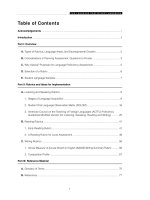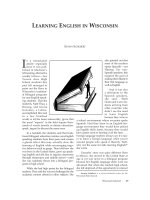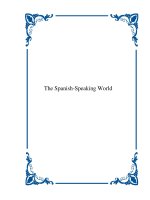Tài liệu Lesson 5- Hull Construction(2) doc
Bạn đang xem bản rút gọn của tài liệu. Xem và tải ngay bản đầy đủ của tài liệu tại đây (166.79 KB, 5 trang )
Lesson 5- Hull Construction(2)
In addition to shell structure, there are bottom structure, side structure, deck
structure, bulkhead structure, bow and stern structure and superstructure, too.
Ship bottom will normally be in two different patterns, single bottom and double
bottom. The double bottom is devised to carry oil and water so as to make full use of
bottom space as well as to lower gravity center, improve on seakeeping performances and
adjust trim and heel through ballast water.
In the bottom structure, the central stringer is a longitudinal member located at the
centreline of bottom from bow to stern, which assures you of the total longitudinal
strength of hull. Side girders are also longitudinal members situated at both sides of the
centreline of bottom, which mainly withstand the total longitudinal bend.
Floor plates play the part of chief transversal members at the bottom, which are
subjected to water pressure and gravity of cargoes and equipment as well as local external
forces. They shoulder the responsibility of transversal and local strength of bottom.
Besides, inner bottom longitudinal and inner bottom plates and the like will also be
adopted for the bottom structures as well.
As it were, the side structures port and starboard are two side walls of hull
symmetrical to each other, and among the side structures leading components are the
frames that bear water pressure and secure the transversal and local strength of hull.
Side structures are subdivided into two models, i. e. the transversal framing and the
longitudinal framing.
With regard to the deck structure, it is made up of deck plates,beams, deck girders,
deck longitudinal, hatch trunks, pillars and other members.
Fig. 5. 1 Hull's main member
In dealing with the deck structure, one thing is very interesting, that is, the arc from
port to starboard is termed as camber while that from bow to stern is called sheer.
Next comes the bulkhead structure which may assume the forms of either plain
plate with stiffeners or corrugated plate. The former is composed of steel plates and
stiffeners while the latter is steel plates pressed into corrugated shape. Bulkheads
employed to prevent oil and water from leakage are put as oil-tight or water-tight
bulkheads respectively. Bulkheads arranged along the ship length are called longitudinal
bulkheads whereas those along the ship width are named transversal bulkheads.
The principal function of bulkheads is to separate the inner space of hull so as to
guarantee vessel floodability and keep fire hazard and poisonous gas from spreading, not
to mention the strength concern.
In respect to the bow structure and stern structure, the former usually denotes the
zone from bow up to 0.15 times of the ship length starting from fore perpendicular to aft,
while the latter indicates the zone after the bulkhead of aft peak.
The external forces exerted on the bow structure include water pressure and wave
impact during voyage while the stern structure endures water pressure, vibration resulting
from propeller operation and wave impact stirred up by propeller.
Furthermore, it is necessary to point out that the adoption of local strengthening is
a common practice for the above two structures.
In the end, we shall come to the superstructure which, as mentioned above, refers
to the hull construction above the upper deck. The typical superstructure only denotes the
construction the two side walls of which, port and starboard, are joined together to side
shell plating. Another kind of superstructure is called deckhouse, the breadth of which is
smaller than ship width and correspondingly whose side walls are not linked to side shell
plating.
In addition, the superstructures at bow, at midship and at stern are respectively
defined as forecastle, bridge and poop. And the term long bridge refers to the bridge the
length of which is larger than 0. 15 times of ship length and the height of which is not to
be less than six times of the headroom between two decks.
New Words and Expressions
1. bottom structure kết cấu đáy
2. side structure kết cấu mạn
3. deck structure kết cấu boong
4. bulkhead structure kết cấu vách
5. bow and stern structure kết cấu mũi và đuôi
6. single bottom đáy đơn
7. double bottom đáy kép
8. trim n . nghiêng dọc
9. heeln.nghiêng ngang
10. ballast water nước ba lát
11. stringer n dầm dọc.
12. member n.thành phần,bộ phận
13. the total longitudinal strength sức bền dọc tổng hợp
14. side girder dầm mạn
15. the total longitudinal bend việc uốn dọc tổng hợp
16. floor plate tấm ngang đáy
17. inner bottom longitudinal cơ cấu dọc đáy trong
18. inner bottom plate tấm đáy trong
19. frame n.khung
20. transversal framing khung ngang
21. longitudinal framing khung dọc
22. deck plate tấm đáy
23. beamn.xà ngang boong
24. deck girder dầm dọc boong
25. deck longitudinal cơ cấu dọc boong
26. hatch trunk quầy miệng hầm hàng
27. pillar n.cột chống
28. arc n.cung
29. camber n.độ cong ngang boong
30. sheern.độ cong dọc boong
31.stiffener n.dầm gia cường
32. corrugated a .được uốn sóng
33. oil-tight a.kín dầu
34. longitudinal bulkhead vách dọc
35. fire hazard hoả hoạn
36. poisonous gas khí độc
37. fore perpendicular đường thẳng góc mũi
38.aft a.adv.n.phía sau
39. aft peak hầm nhọn phía đuôi
40. vibrationn .rung động
41. practice n.thực tế
42. deckhousen.buồng trên boong
43. forecastlen.thượng tầng mũi
44. bridgen .lầu lái
45. poopn.thượng tầng đuôi
46. long bridge lầu lái dài
47. headroom n .độ cao giữa hai boong
Verb Phrases and Collocations
1. so as to (tương tự in order to -để cho,ví dụ : I always keep fruit in fridge so as to keep
insects off it)
2. make full use of lợi dụng toàn bộ
3. improve on (upon) cải thiện
4. assure sb. of sth. bảo đảm với
5. play the part of đóng vai trò
6. as it were có thể nói
7. be symmetrical to đối xứng
8. be subdivided into được chia ra
9. with regard to xét tới
10. take (assume) the form of nhận hình dáng của
11. keep sth. from ngăn chặn khỏi
12. result from do nên
13. stir up khích động ,khêu gợi
14. point out chỉ ra
15. in the end cuối cùng
16. be joined to nối với
17. be linked to nối với
BÀI 5-KẾT CẤU THÂN TÀU(2)
Ngoài kết cấu vỏ,còn có kết cấu đáy,mạn,boong vách,mũi,đuôi và kết cấu thượng
tầng.
Đáy tàu thường có hai loại,đáy đơn và đáy kép.Đáy kép được tạo ra để chở dầu và
nước để sao cho sử dụng hết không gian đáy cũng như để hạ thấp trọng tâm,cải thiện tính
năng hàng hải và điều chỉnh độ nghiêng ngang và dọc thông qua nước ba lát.
Trong kết cấu đáy,dầm trung tâm là một thành phần dọc nằm tại đường tâm đáy
từ mũi về đuôi ,đảm bảo sức bền dọc tổng cộng của thân tàu.Những dầm bên cũng là
những thành phần dọc nằm cả hai bên đường dọc tâm đáy ,chủ yếu chịu đựng sự uốn dọc
tổng công
Các tấm đáy đóng vai trò các thành phần ngang chủ yếu ở đáy tàu ,chịu áp lực
nước và trọng lựơng của hàng hóa và trang bị cũng như các ngoại lực cục bộ.Chúng chịu
trách nhiệm về sức bền ngang và sức bền cục bộ của đáy tàu.
Ngoài ra,tấm dọc đáy trong và các tấm đáy trong khác cũng được coi là kết cấu
đáy.
Như ta đã thấy,kết cấu mạn trái và mạn phải là hai thành bên đối xứng với nhau
.và trong kết cấu mạn ,những thành phần chủ chốt là những khung sườn chịu áp lực nước
cũng như đảm bảo sức bền ngang và sức bền cục bộ của thân tàu.
Kết cấu mạn được chia thành hai kiểu,đó là khung sườn ngang và khung dọc.
Xét về kết cấu boong,nó tạo bởi các tấm boong,dầm ngang ,sống boong,thanh dọc
boong,quầy miệng hầm hàng,các cột chống và các thành phần khác.
Hình 5.1 Thành phần chính của thân tàu.
Xét về cấu trúc boong,một điều đáng chú ý là cung nối mạn trái và mạn phải được
gọi là đường cong ngang boong,trong khi từ mũi tới đuôi thì gọi là đường cong dọc
boong.
Tới đây ta xét tới kết cấu vách ,nó có thể là vách phẳng với gia cường hay vách
sóng.Vách phẳng gồm có các tấm thép phẳng và những thanh gia cường ,trong khi vách
kia là những tấm thép đã được ép thành hình lượn sóng.Những vách dùng để ngăn dầu và
nước khỏi dò gỉ lân luợt được gọi là vách kín dầu và kín nước.Những vách chạy dọc theo
chiều dài tàu gọi là vách dọc trong khi vách ngang thân tàu gọi là vách ngang.
Nhiệm vụ chủ yếu của vách là phân cách khoảng không gian bên trong tàu sao cho
đảm bảo được tính chống chìm và ngăn cho cháy và khí độc không lan tỏa ,đó là chưa nói
tới đảm bảo sức bền.
Về kết cấu mũi và đuôi,kết cấu mũi là vùng từ mũi tới 0.15 chiều dài tàu đo từ đường
thẳng góc mũi tới đuôi ,trong khi kết cấu đuôi là vùng nằm sau vách nhọn đuôi.
Ngoại lực tác dụng vào kết cấu mũi là áp lực nước và va đập sóng trong hành trình
trong khi kết cấu đuôi chịu áp lực nước,dao động do chân vịt và va đập sóng do chân vịt
khuấy động.
Ngoài ra ,cần phải nhấn mạnh rằng việc gia cường cục bộ tại hai khu vực nói trên là
việc thường phải làm.
Cuối cùng chúng ta nói tới thượng tầng,như đã nhắc tới ở trên,đó là kết cấu thân tàu
nằm trên boong trên.Thượng tầng điển hình chỉ là kết cấu mà hai thành bên của nó ,bên
trái và bên phải được nối tiếp cùng với các tấm tôn mạn.Một loại thượng tầng khác gọi là
lầu lái có chiều rộng nhỏ hơn chiều rộng của tàu và như vậy hai thành bên của nó không
nối với tấm mạn.
Ngoài ra thượng tầng tại mũi ,giữa tàu và đuôi lần luợt có tên là thượng tầng
mũi,thượng tầng giữa và thượng tầng đuôi .Và thuật ngữ thượng tầng lài dài là chỉ thượng
tầng lái có chiều dài lớn hơn 0.15 chiều dài tàu và chiều cao của nó không nhỏ hơn 6 lần
khoảng cách giữa hai boong









